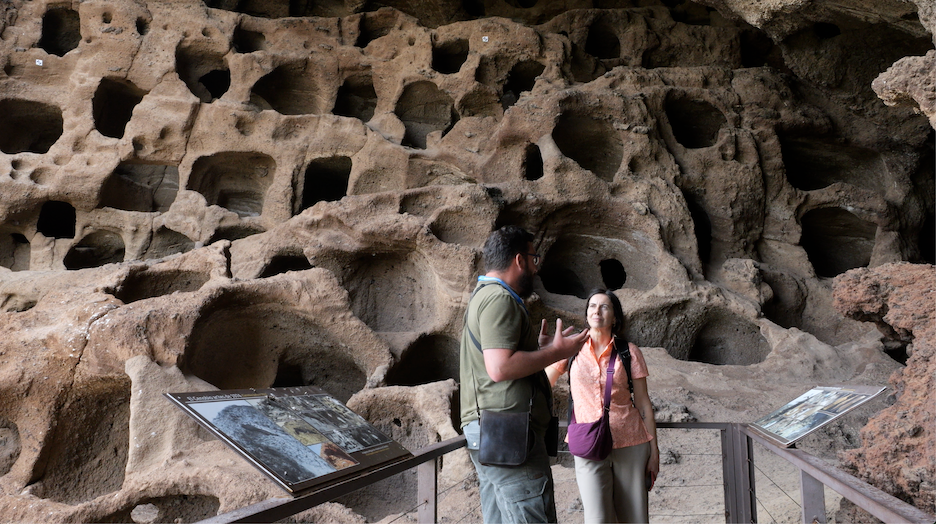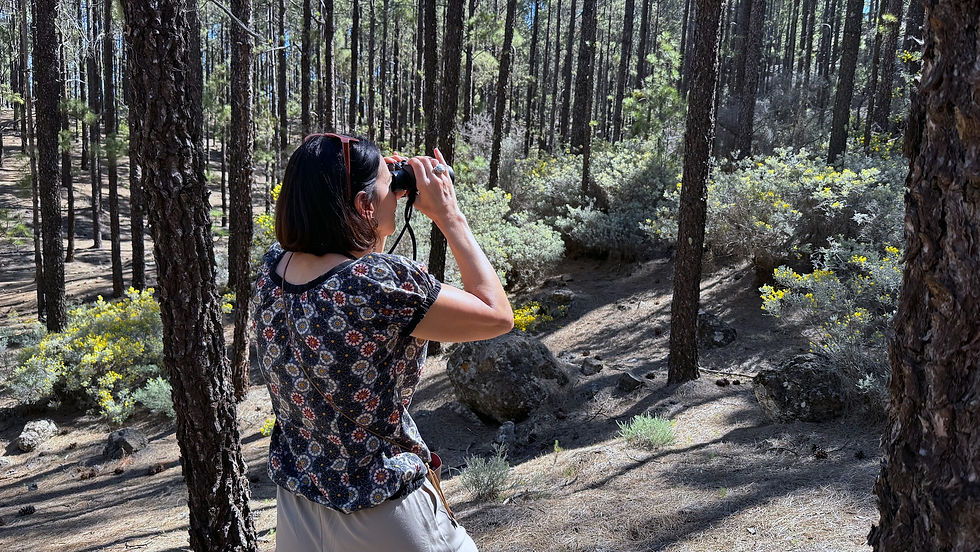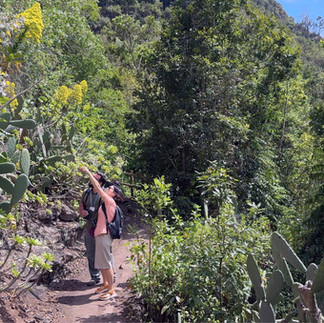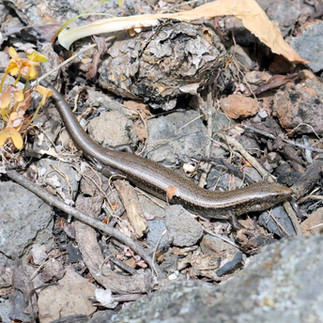Wildlife watching and hiking on Gran Canaria
- Teresa Machan

- Aug 22, 2025
- 7 min read
Updated: Aug 24, 2025
Teresa Machan marvels at the diversity of wildlife and rich cultural heritage of the 'miniature continent' of Gran Canaria on an ecotourist trip across a less visited part of the island
It’s not often you get to walk through a prehistoric forest before lunch but, there we were, my guide Guillermo and I, in one of Gran Canaria’s last remaining pockets of laurel forest. Our walk in Los Tilos de Maya in the northwest of Gran Canaria was accompanied by the trill of pipits, chiffchaffs and robins.

Teresa and Guillermo admire the age-old laurel forest in Los Tilos de Maya in the northwest of Gran Canaria. Photo: Richard Hammond
Peach-tinted aeonium rosettes caked the walls of the forest ravine and from a tangle of green, grew wild sweet peas and nasturtiums. Full of enthusiasm Guillermo, an ecotourism nature guide and owner at Gran Canaria Sightseeing, showed me the spiny fingers of the cardon cactus, the rare Cresta de gallo de Moya (Isoplexis chalcantha’) – “exclusive to this ravine and endemic only to this forest” – the glossy ‘blistered’ leaves of another endemic which shares a symbiotic relationship with spiders, and the cochineal beetle which is hosted by the fleshy ears of the prickly pear and used for its red dye.
The trees around us date to the Tertiary period, approximately 66 million to 2.6 million years ago. We see a laurel pigeon in flight and then, under the laurel canopy, Guillermo spotted the dusky blue and pale apricot hues of a male Canary Islands chaffinch on a branch. It flitted from the tree to the forest floor where a chestnut-breasted Gran Canaria robin hopped in to join it. “There you have it. A photo bomb and two endemics in one frame.”
Some of the variety of flora and fauna we saw in Los Tilos de Maya. Photo: Richard Hammond
Gran Canaria is not called the “miniature continent” for nothing. Precious forests, volcanic landscapes, epic sand dune and pine-covered mountain peaks might come as a surprise to those who are more familiar with popular beach-holiday haunts in the south. The Gran Canaria Biosphere Reserve encompasses almost half of the island (100,00 hectares) and among its bounteous collection of flora and fauna is one of Europe’s rarest songbirds, the Gran Canaria Blue Chaffinch (see video below - we got to see and hear the beautiful Blue Chaffinch!).
Watch the video of Teresa's trip to Gran Canaria:
Filmed and edited by Richard Hammond. A Green Traveller production.
A network of scenic walking paths ranges from easy strolls like ours in Tilos de Maya, which took less than two hours, to miles of footpaths that take hikers to ravines, forested peaks, calderas and majestic monoliths. A recently established 100km hiking route (GR139) that covers the rugged southwestern part of the island loops numerous peaks. The shortest of five sections, at 4.5 hours, takes in the pine forest of Tirajana and the longest, which crosses part of the volcanic crater, Caldera de Tejeda, takes around 7.5 hours.
In the north of the island walking and cycling routes fan out from the small towns of Tejeda, Agaete, Artenara, Teror and Galdar. As well as being a great location for low impact adventures, this part of Gran Canaria is also a great place for those wanting to learn about the island's cultural heritage. Located on the island’s northeastern tip Galdar, is a must-visit for those interested in the history of Gran Canaria. The vibe here feels authentic and unhurried. Children played in the squares, locals took time to chat and on weekday mornings retired couples were tucking into plates of churros.

Tejeda, one of several towns in the north of Gran Canaria blessed with stunning views. Photo: Richard Hammond
Pre-Hispaninc ‘Agaldar’ was the island’s first capital and one of two kingdoms into which Gran Canaria was divided before the Castilian conquest in the late 15th century. At the distinctive Hotel Algadar, overlooking the tree-lined Plaza Grande, room names and decorative motifs nod to the island’s aboriginal ancestors, the Amazigh, thought to have descended from the North African Berber tribes.
Around the corner from the hotel is the Church of Santiago de los Caballeros. Its Holy Door is the final stop for pilgrims on the Camino de Santiago in Gran Canaria, which begins at the dunes of Maspalomas. Galdar’s church, Museum of Sacred Art and handsome neo-classical buildings are reason enough to visit, but it was a mishap on a banana plantation that gives the town its star attraction.
While digging at a root in the mid-1800s an agricultural worker put a hole in the roof of a cave, revealing an aboriginal Canarian settlement of more than 50 dwellings dating to the 6th century. The Cueva Pintada Museum and Archaeological Park is now the largest archaeological site in the Canarian archipelago. A walkway skirts the site, which is still under excavation, but of particular interest is the Cueva Pinctada (painted cave) where geometric patterns were painted using three pigments.
Caves and mountains around the island were used as troglodyte dwellings, grain storage, burial and ritual purposes and for astronomical observations. Gran Canaria is the only island on which pre-Hispanic dwelling complexes were built into caves – which can be seen at Acusa Seca and in the town of Artenara.
Two of the most intriguing sites are at Risco Caido and Cenobio de Valeron. The honeycomb-like cave structure El Cenobio de Valeron is high on a mountain slope where a short, steep ascent up manmade steps reveals more than 200 interconnected grain silos that were hollowed from the rock face. Marks where doors were fitted can still be seen.

Teresa and Guillermo at the honeycomb-like caves pf El Cenobio de Valeron. Photo Richard Hammond
The cave network of Risco Caido is thought to have been used as an astronomical marker. Twice a year, at the summer and winter solstice, sunlight or moonlight enters a gap in the roof of one its 21 caves, illuminating a series of rock art engravings.
The culture and rituals of the Amazigh are explored in detail at an interpretation centre at Roque Bentayga. Along with Roque Nublo, this hallowed monolith forms part of the UNESCO-designated Risco Caido and the Sacred Mountains of Gran Canaria cultural landscape. The walk to a lookout point takes about 40 minutes. Stopping many times to take in the spectacular panoramas I followed Guillermo along narrow, rocky footpaths until we emerged at a plateau on the rock’s eastern face where there is an ‘almogarén’, or sacred worship place.
That evening, assisted by a pair of professional, stargazing eyes, I would embark on some astrological observations of my own, at the Parador Cruz de la Tejeda. After lunch and a stroll around the pretty village of Tejeda we zig-zagged skywards, coming to a stop above the crag-filled caldera.
On a clear day views from the parador’s rooms and infinity pool stretch all the way to the distant peak of Mt Teide, on neighbouring Tenerife, and in the morning and evening a sea of cloud rolls between the peaks like a horizontal waterfall. You could be forgiven for never leaving the parador, but trails lead directly from the parador to Roque Nublo and the Caldera de Bandama nature reserve, and there are cycling trips through forests of Canary pine in the Nublo Rural Park.

Pool with a view: Teresa taking a dip at Parador Cruz de la Tejeda. Photo: Richard Hammond
Far from pollution, at 1,500 metres above sea level, the air is crisp and clear. At night, with the aid of a professional telescope, the parador’s terrace holds a mirror to the night skies. Late that evening, after watching the sun dip behind Teide, I made my way up to the terrace where StarLight instructor Frank Rodriguez, from AstroEduca, guided us through the galaxies, nebulae, clusters and double stars hiding in the star-speckled dark sky.
“We have more than 290 clear nights at altitudes above 1,600 metres”, he told us. “Gran Canaria is a good view point for the southern cross, for example, a constellation impossible to see from continental Europe.”
My visit to Gran Canaria ended as it had begun, birdwatching in a forest. Llanos de la Paz is one of two nesting areas for the Gran Canaria Blue Chaffinch, a bird Guillermo was keen to add to our sightings. We padded through the forest on a carpet of pine, spotting a plain swift, an African blue tit, a Berthelot’s pipit and a trio of ravens.

Teresa looking for the rare Blue Chaffinch in Llanos de la Paz. Photo: Richard Hammond
With a canny knack for hearing birdsong hundreds of metres away, Guillermo then identified the cry of woodpecker chicks. The chirping led us to a tree, where a pair of great spotted woodpeckers were engaged in a chick-feeding relay. We sat for a while, enjoying their colourful plumage and the relentless cacophony emanating from the trunk.
On the way back Guillermo hears the song of the blue chaffinch. We change direction and within minutes we find one, and then another, high up in a pine tree. “Of an estimated 450 birds there are only 70 in this particular forest,” says Guillermo.
And here are two of them – a bird that can be seen nowhere else in the world. This mid-Atlantic isle is full of pleasant surprises.
==
Disclosure: Teresa Machan was a guest of Gran Canaria Tourism. She had full editorial control of this feature, which has been written in her own words based on her experience of visiting Gran Canaria in the summer of 2025. All opinions are the authors’ own.
How to travel to the Canary Islands without flying
There are two ferry routes from mainland Spain to the Canary Islands, from Huelva (near Seville) operated by Baleria, and from Cadiz, operated by Armas Trasmediterránea. For how to travel to these ports from the UK without flying, see our guide to how to travel overland to Spain.
The ferries from Huelva run to the Port of Santa Cruz de Tenerife (which takes about 40 hours) and stop at the Port of La Luz in Las Palmas de Gran Canaria en route, while the ferries from Cadiz run to most of the main islands, including Fuerteventura, Gran Canaria, La Palma, Lanzarote and Tenerife, taking 28–35 hours.
Ferry tickets provided by Direct Ferries, which allows you to search and compare prices for the different operators and routes from the mainland ports in Spain to the Canary Islands.






















Comments